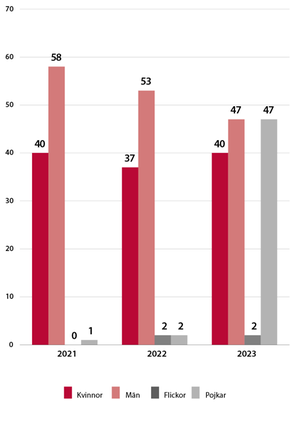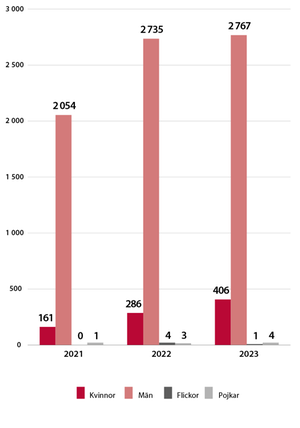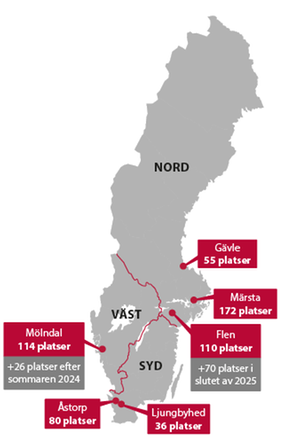The Swedish Migration Agency answers: what is a detention centre?
The Swedish Migration Agency’s detention centres are for people who do not have the right to stay in Sweden and must therefore leave the country. Return is the primary purpose of the operation. This is reflected in the people who end up there, how the detention centres are designed, and how things work inside a detention centre.
Who can be detained?
Under certain circumstances, people without permission to stay in Sweden who are to be removed from the country (refused entry or expelled through deportation) can be detained. Detention is mainly used to ensure that a person is available to leave the country, and if there is a risk that the person will abscond or otherwise prevent their removal.
Both refusal of entry and expulsion mean that a person must leave Sweden. “Removal” is used as an umbrella term for these actions. The difference between refusal of entry and expulsion is that a refusal of entry decision is made within three months of a foreigner arriving in Sweden, while an expulsion decision is made after three months have passed. In this text, the word “removal” is mainly used to cover these various concepts.
If necessary, detention can also be used to investigate whether someone has the right to stay in the country, or if their identity is unclear. Common to all detention decisions is that a supervision decision is deemed insufficient. A supervision decision is made when there is risk that someone will abscond or refuse to cooperate, and means that a person must report to the police or the Swedish Migration Agency at certain, specified times. Detention decisions can always be appealed in court.
 Zoom image
Zoom imageAverage length of stay (in days), 2021–2023
People who have received an expulsion decision from the court because they committed a crime may also be detained after serving their sentence, if their return cannot be carried out immediately after their sentence has been served. In the case of more serious crimes, the person will usually remain in the custody of the Swedish Prison and Probation Service pending their removal, but an individual assessment that takes into account different circumstances is always made.
A detention decision concerning the enforcement of an expulsion decision is valid for a maximum of two months. Following negotiation, the decision can be extended for a further two months, for up to a maximum total of twelve months. If enforcement has not been carried out within that time, the detention decision must be rescinded (cancelled). An important exception is people who are to be deported because they committed a crime, in which case there is no upper time limit.
Children can be detained
Children can be detained while awaiting deportation, but they cannot be separated from their legal guardians, if they are in the country. Unaccompanied minors can also be detained, although this is unusual. An important difference to adults is that children may only be detained for 72 hours, with the possibility of an extension for another 72 hours.
Whenever possible, children and families in detention are placed in special wards adapted for children. Among other things, these wards have play activities and staff with special expertise.
Locked from the outside – open inside
A detention centre is a locked accommodation, but inside the premises intended for detainees, they can move around freely. They sleep in shared rooms, and bathrooms are also shared. The premises include a living room, dining room, and exercise room. There are also “quiet rooms” for quiet activities such as meditation, reading, or prayer.
The Swedish Migration Agency provides computers that are connected to the internet, which detainees can either use in common areas, or in some cases in their rooms. Data traffic is not monitored, and there are no filters that limit how web surfing. However, there are rules that the detainees must follow – for example, it is not allowed to visit pages with offensive content.
During the day, there are fixed times for meals and outdoor activities. Otherwise, the detainees can dispose of the time freely, to the extent that they do not have any scheduled appointments, .e.g, in connection with the investigation of their case or preparation for their outward journey. At the detention centres, there are employees who are responsible for carrying out organised activities, such as various types of physical exercise, educational initiatives, or activities of a more creative nature. NGOs also sometimes carry out organised activities for the detainees inside the wards.
 Zoom image
Zoom imageNumber of completed detentions, 2021–2023.
Detention is not just for detaining people
The purpose of someone’s stay at a detention centre is mainly to enforce their expulsion decision. This means that the staff work actively on the case during the detainee’s time there. Their identity must be clarified if this could not be done earlier, valid documents must be obtained, and the detainee must be persuaded to return voluntarily. If the person does not cooperate, the case is handed over to the Swedish Police Authority, which can use force to implement the decision.
Last year, around 3,000 people were held in Swedish detention centres for some period of time – see graphic – and during the same period, just under 2,400 deportations of people in detention were carried out.
The detention centres have staff who are responsible for conducting exit interviews and making decisions in detention and return cases. There are also detention officers, who work to carry out activities, provide meals, hold counselling sessions, manage transport to various types of care facilities, and serve as a social support for detainees during their stay.
Safety is paramount
Safety is a major and crucial aspect of detention centre operations. Regardless of their professional role, all employees, have a responsibility to ensure that the detention centre is a safe and secure place, for both detainees and staff. One of the keys to maintaining a safe environment is to create relationships and build trust and confidence in the detainees during their stay.
All employees at the detention centres undergo basic training that covers such topics such as the role of a civil servant, conversation training, counselling, CPR, legislation, how to treat people who are feeling unwell, and more. Their education also includes security training, to ensure order and safety at the detention centre. All detention centres have a nurse on-site during the week.
In connection with the renovation and new construction of detention centres, security work and technology are designed to be better suited to their purpose. Perimeter protection has been improved in recent years through the installation of high fences to keep unauthorised people out and prevent escapes.
Sweden’s detention facilities are being expanded
At present, Sweden’s detention centres have room for 567 people. These spots are distributed among detention centres in six different places in the country – see map. Pursuant to a Government mandate, an expansion of Sweden’s detention facilities is underway, with the aim of increasing their capacity to 1,000 people, to increase the efficiency of returns. The expansion is being coordinated with the Swedish Migration Agency’s other mandates, such as the reformation of the reception process and the establishment of return centres.
